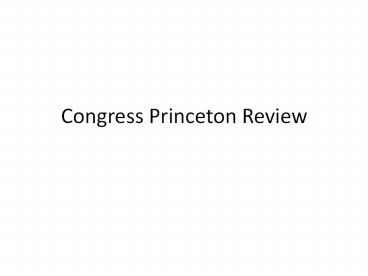Congress Princeton Review - PowerPoint PPT Presentation
Title:
Congress Princeton Review
Description:
Race can not be the sole or predominant factor in redrawing legislative district boundaries. Important Voting Rights Court Cases U.S. Term Limits v. – PowerPoint PPT presentation
Number of Views:80
Avg rating:3.0/5.0
Title: Congress Princeton Review
1
Congress Princeton Review
2
Congress
- Bicameral (two-house) legislature responsible for
writing the laws of the nation. - Congress also serves other functions, such as
overseeing the bureaucracy, consensus building,
clarifying policy, legitimizing, and expressing
diversity.
3
Congress
- Made up of
- House of Representatives
- 435 members
- Senate
- -100 Members
4
Congress
- Every 10 years a census is taken by the federal
government to count the population to determine
the number of each states congressional
districts. - Each state must then redraw its congressional
boundaries to ensure that each district is equal
in population.
5
Congress
- Congressional redistricting is done by each state
legislature. Therefore, the political party in
control of the state legislature controls how the
districts are drawn. - The legislature will gerrymander the district
boundaries to give the majority party an
advantage in future elections.
6
Congress
- Elections for all the 435 seats of the House of
Representatives occur every two years. - Must reside in district
- Be citizen of the state
- Be at least 25 years old
- Constituencies of representatives are small
compared to those of Senate. - House incumbent election rates are 90 percent,
not much of a challenge.
7
Congress
- Elections for one-third of the Senate occur every
two years, with a senators term lasting six
years. - Senate elections are more competitive.
8
Important Voting Rights Court Cases
- Smith v. Allwright (1944). The denying of
African Americans the right to vote in a primary
election was found to be a violation of the 15th
Amendment. - Wesberry v. Sanders (1963). Ordered House
districts to be near as equal as possible-
enshrined the principle of one man one vote.
9
Important Voting Rights Court Cases
- Buckley v. Valeo (1976). The court ruled that
giving money to a political campaign was a form
of free speech and threw out some stringent
federal regulations on fund-raising and election
spending. - Shaw v. Reno (1993) and Miller v. Johnson (1995).
Race can not be the sole or predominant factor
in redrawing legislative district boundaries.
10
Important Voting Rights Court Cases
- U.S. Term Limits v. Thorton (1995). States
cannot set term limits on members of Congress. - Bush v. Gore (2000). Florida recount in the
election of 2000 was ruled to be a violation of
the 14th Amendments equal protection clause.
11
(No Transcript)































